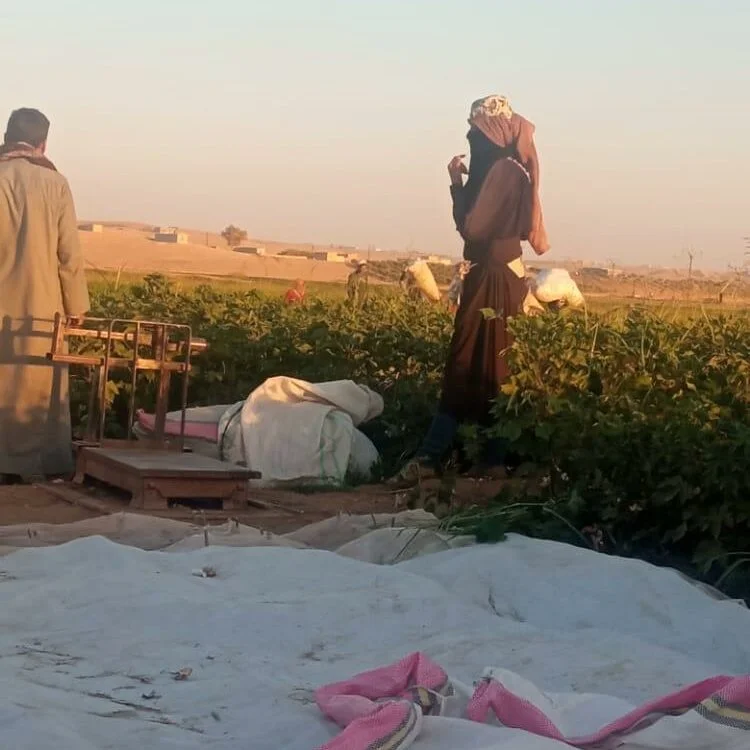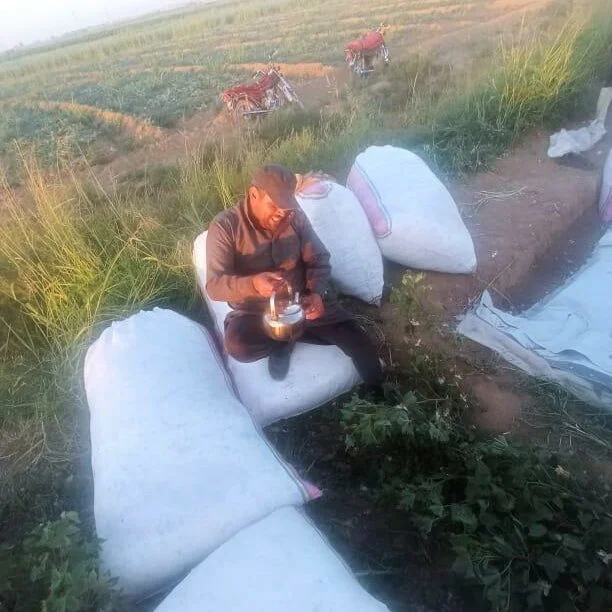by Jabbar Abdullah
Cotton is one of the main crops grown in Raqqa. The region/the city is the number one producer of cotton in Syria, with more than 135,000 hectares of land typically involved in this form of agriculture, yielding more than 250,000 tonnes of cotton. The annual revenue from the crop is one of the main sources of income for Raqqa’s residents. This income does not only relate to the sale of produce at the end of the year but the income received by the many male and female workers who receive a fixed cash wage for their work during the harvest season which lasts over five months, starting in May and ending in September.

My family also owns land where my father planted cotton every year or second year. I still remember the cotton harvest well when I was a small child. We all helped. As soon as my school ended at noon, I ran home, threw my books in my room, and got rid of my uniform. After a quick meal, I ran over to the field. Often I could not find my mother in the crowd of workers. In addition, I was extremely shy. So instead of calling for her, I ran through the lanes of the field past all the people and tried to hear my mother’s voice. Often I was unlucky. But when I found her, she was always happy to see me. Then I would help her a little with the harvest or take her sack to the scales and bring her water.
My mother had quick hands and did good work – I often tried to imitate her finger technique in harvesting and ended up with bloody fingers and tired hands only after a few minutes. Then I would help her a little with the harvest or take her sack to the scales and bring her water. Despite everything, I was able to learn quite a bit about cotton harvesting and the various working stages.
| Cultivating the land
The first stage consists of cultivating the land using special tractors. The seeds are then sown mechanically. For that the land is divided into cubic squares with an area of around one hundred or more square metres each. The sides of the square cubes are surrounded by soil furrows that are each around 40cm high and 50cm wide. Between each row of squares aligned one behind the other, irrigation canals are built that are more than one metre wide and are as long as the plot of land. The purpose of creating furrows and irrigation canals is to supply the cotton at a later point with sufficient water, as cotton normally requires a large amount of water. It is watered more than seven times during the harvest season and each time the panels are filled completely with water. Watering is usually carried out by one person called the saqi (irrigation worker). For this work, a specific tool tool is necessary – a shovel or al-karuk in the local language. Watering takes place by passing water through the water wheel which divides the land from the start to the finish. When starting, each panel makes an opening in the canal furrow and at the same time a soil furrow is made within the water canal. In this way, the water is contained so that it flows into the target panel. The panel usually takes around half an hour to be completely filled. The saqi has to patrol each of the four panel furrows from time to time, sometimes more than once, to make sure that the panel has not split due to water pressure and that the water has not thus spilled out. A time consuming task – but the saqi is smart and knows how to effectively save time: If the saqi wants more time to eat or drink tea, he divides the water between two panels at the same time by making one opening in one of the furrows shared with the next panel. This saves more time so that he can gather firewood and light the fire under the teapot.
Almost one and a half months after the initial irrigation stage, the plants start to grow and reach an average height of twenty centimetres above the ground. This starts the stage of removing weeds that grow between the cotton shrubs. This task is often done by women who work together and organise themselves into groups or “workshops” coordinated by a man called the shawish (foreman). This independent job is carried out by a man with a long history of it. The quality of his work involves experience, trust and an ability to deal with both the workers and the landowner. Between twenty and fifty women work with each shawish. His basic task is to coordinate between the landowner and the workers concerning the timetable, type of tasks, transport of workers to the land and financial matters. He has also to ensure that the workers’ work is of good quality and satisfactory to the landowner.
| Weeding and Thinning
At the beginning of each season, the landowners contacts the shawish to get the dates of the weeding and subsequent stages. Each shawish usually takes on more than 40 hectares each year and this depends on the number of workers in his workshops. The weeding stage usually takes place in the early morning at 5am. After two hours of work, the workers take a break and sit down to have breakfast. The shawish bring them large 5-litre pots of tea that are heated using camping gas stoves, one of the most important implements the shawish has. After the break, they continue working until 11am, when the heat of the sun becomes so hot that it becomes difficult to continue working. The shawish then usually takes the workers home for a lunch break, until 2.30 pm. They are collected again once the temperature has cooled down. After their lunch break, the women work for around another three hours. The workers remove the weeds by striking their roots with the head of a pick. This requires skills in order to avoid the nearby cotton bushes and their roots.


The weeding stage is followed by the thinning stage, when the density of the cotton bushes is reduced by removing excess cotton bushes by hand. This stage is important to create sufficient space between bushes to give them enough space to breathe and for branches to sway comfortably. Cotton bushes that have been removed are usually filled into large sacks to be used as fodder for sheep and domestic livestock.
After the thinning stage agro-chemical fertilisers are applied to strengthen the roots of the plants and gives them the desired fruitfulness. This stage is carried out by men at two different times. The fields must be watered immediately after each one on the same day so that the plants are not burned by the heat of the fertiliser. The fertiliser stage is quick and only requires work by hand. The men place a specific amount of the fertiliser onto a piece of cloth that might be a shawl, for example. This shawl is tied to the waist on all four sides so that it resembles a sack that is open at the top. The man then takes a handful of fertiliser that he scatters left and rights while walking forward slowly. More than one tonne of fertiliser is typically used per hectare.
After several months, the cotton bushes grow and reach a height of over 60cm. The foliage become large and dense with a bright green colour and branches from which cotton flowers have started to bloom.
| Cotton Picking Season
The cotton picking season starts in September. There are specific activities involved at this stage that make the general atmosphere one of happiness and joy at the harvest and the material benefits for all the residents of the town.
The first day starts with a visit at 4 am to the homes of all the female workers one after the other. The women are ready to get into the car when they hear the horn the driver blows to let them know he has arrived. It takes around one hour to collect the women and take them to the field. When the workers get to the field, they spread out next to each other, leaving an area of two metres between one worker and the next. This area is the picking area for each worker and extends from the start of one field to the next. The workers have a plastic sack in which they collect the cotton they pick. The large sack is made from special plastic filament. The worker does not place the picked cotton into the sack immediately; she first collects what she picks inside a special skirt that she wears and which she folds and ties around her waist to make a small gap in which to place the picked cotton. When the skirt is filled – with around two or three kilograms of cotton – she unloads the content into the sack.
Packaging of the cotton
Once the sack is full, the worker carries it to the weighing scale to be weighed by the shawish, with the weight, date and time written on the page allocated to each worker. After the weighing, one of the men takes the sack to unload it into a cotton sack, a large canvas sack, that holds around 200 kilograms of cotton, in which the men climb in to compress the cotton with their feet. The sacks are placed into a dug hole to keep them fixed. Once the cotton sack is full, its opening is sewn together with a special cotton thread like a net.

Each worker usually picks between seventy and eighty kilograms per day. Work is continuous from morning until the evening, without a break at home, during the cotton picking season as the weather is cool. The time passes quickly as the women talk to each other as they work. From time to time, you can hear the sound of women singing here and there and sometimes there are minor quarrels between the workers, especially if one worker goes over her line of bushes into the line of another worker. The shawish is responsible to assess the work of each worker by looking at the bushes they have picked. If the cotton bolls have no more cotton left in them, the worker had done a good job and her pickings are clean.

Quality Check
The shawish also looks carefully at the sack when it is unloaded into the larger cotton sack to make sure that the cotton is clean and does not contain leaves or boll husks. Leaves that are mixed in with the cotton ultimately affect the landowner when he sells the harvest; the cotton sacks are inspected by specialists who assess the product and base its price on cleanliness.
Once the picking is over, the produce is transported by a truck to the state-owned cotton centre. There, the driver waits outdoors for one or two days due to the large number of trucks waiting for their turn. After around two months, the state announces is decision on pay for the farmers’ produce. Each farmer then goes with their receipt to a specified centre to receive their payment. After that, each famer contacts the shawish to give him the harvest account. He then visits the homes of each worker by car to give them the money which he keeps in a large bag. He sits in each house for half an hour, surrounded by the workers from the house. The shawish opens his notebook and calculates the total cotton picked by each worker. When the workers have received their pay, the celebrations can start.
| Cotton Harvest around Syria
Feature Image: Kimberly Vardeman – CC BY 2.0

How to harvest the cotton properly and correctly?